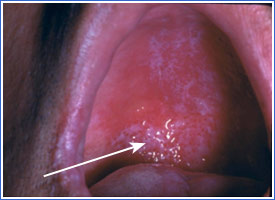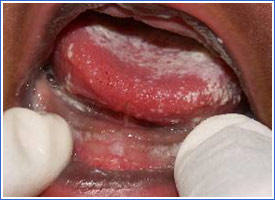Candidiasis
Oral candidiasis can exhibit a variety of clinical patterns, and is most commonly seen in newborns or the immunocompromised.
Pseudomembranous Candidiasis
Often referred to as thrush, it is the most common form and may present with a burning sensation.
Other forms of candidiasis:
- Median rhomboid glossitis presents as a well-demarcated, roughly symmetric, red lesion on the midline of the posterior dorsal tongue. It is three times more common in men than women. Causes no symptoms.
- Erythematous candidiasis, also called denture stomatitis, causes localized or generalized red, flat lesions accompanied by a burning sensation. This may result from poor cleansing of dentures and leaving dentures in at bedtime.
- Angular cheilitis, often associated with candidal and staphylococcal infections, is commonly seen in denture wearers.
- Smoking, diabetes, HIV infection, pregnancy, and poor oral hygiene can all contribute to the development of candidiasis.
Pseudomembranous Candidiasis in an Adult

Pseudomembranous Candidiasis (Thrush) in Infant

References
Gonsalves WC, Chi AC, Neville BW, Common Oral Lesions: Part I. Superficial Mucosal Lesions, AFP 2007;75:501-507.
Pappas PG, Kauffman CA, Andes D, et al. Clinical Practice Guidelines for the Management Candidiasis: 2009 Update by the Infectious Diseases Society of America. Clinical Infectious Diseases. 48(5): 503-535.